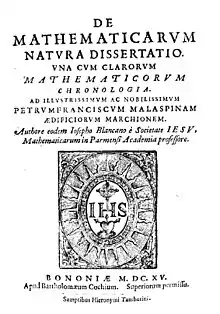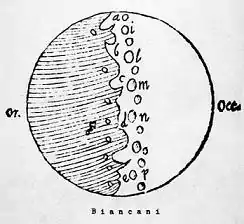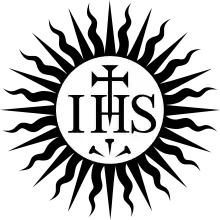Giuseppe Biancani
Giuseppe Biancani (in Latin, Josephus Blancanus) (1566–1624) was an Italian Jesuit astronomer, mathematician, and selenographer, after whom the crater Blancanus on the Moon is named.[1] He was a native of Bologna.


| Part of a series on the |
| Society of Jesus |
|---|
 |
| History |
| Hierarchy |
| Spirituality |
| Works |
| Notable Jesuits |
|
|
His Aristotelis loca mathematica ex universis ipsius operibus collecta et explicata, published in Bologna, appeared in 1615, in which Biancani discussed Aristotelian thought on floating bodies. The work suffered censorship whilst undergoing peer review, a common Jesuit practice. The reviewer, Giovanni Camerota, wrote: "It does not seem to be either proper or useful for the books of our members to contain the ideas of Galileo Galilei, especially when they are contrary to Aristotle."
Biancani wrote his Sphaera mundi, seu cosmographia demonstrativa, ac facili methodo tradita in 1615. However, it was not published until 1619 in Bologna, after the Decree of the Congregation of the Index in 1616.
In his Sphaera mundi, Biancani expounded on his belief that God had made the Earth a perfect symmetrical world: the highest mountain on land had its proportional equivalent in the lowest depth of the ocean.
The original Earth emerged on the third day of the creation myth as a perfectly smooth sphere, Biancani reasoned. If not for the hand of God, "natural law" would have allowed the Earth to remain in that form. Biancani believed, however, that God had created the depths of the sea and formed the mountains of the Earth.
Moreover, if left to "natural law," the Earth would be consumed in water, in imitation of how it was created. However, the hand of God would intervene in order to cause the Earth to be destroyed entirely by fire.
The contents of the book are described in Latin as: Sphaera Mundi seu Cosmographia. Demonstrativa, ac facili Methodo tradita: In qua totius Mundi fabrica, una cum novis, Tychonis, Kepleri, Galilaei, aliorumque; Astronomorum adinventis continetur. Accessere I. Brevis introductio ad Geographiam. II. Apparatus ad Mathematicarum studium. III. Echometria, idest Geometrica tractatio de Echo. IV. Novum.
As evidenced in the table of contents, this work also presented a summary of the discoveries made with the telescope by Tycho Brahe, Johannes Kepler, Galileo, Copernicus, and others. The censorship of Biancani's previous work affected the manner in which he wrote Sphaera mundi. "But that this opinion [heliocentrism] is false," Biancani wrote, during his discussion on Copernican and Keplerian theories, "and should be rejected (even though it is established by better proofs and arguments) has nevertheless become much more certain in our day when it has been condemned by the authority of the Church as contrary to Sacred Scripture" (Sphaera, IV, 37).
The work not only included studies on the natural phenomenon of the echo and on sundials, but also included a diagram of the Moon. Giuseppe Biancani's map was not drawn up in support of new Copernican ideas but those berthed in traditional geocentric cosmology and in support of Aristotelian thought. Biancani disagreed with Galileo, who believed in the existence of lunar mountains. In a 1611 letter to Christoph Grienberger (after whom the Gruemberger crater is named), Biancani wrote of his certainty that there could not be any mountains on the Moon.
Biancani opined that the Copernican system was of opinionem falsam... ac rejeciendam. Nevertheless, Biancani remained ambivalent in the midst of the Scientific Revolution, as he cited Galileo's opinions on the surface of the Moon while also discussing those of the ancients, such as Posidonius and Cleomedes.
Biancani's Constructio instrumenti ad horologia solaria discusses how to make a perfect sundial, with accompanying illustrations.
Bernhardus Varenius based much of his geographical work on Biancani's ideas.
List of works
- Sphaera mundi, seu Cosmographia demonstrativa (in Latin). Modena: Andrea Cassiani & Girolamo Cassiani. 1653.
Sources
See also
- List of Jesuit scientists
- List of Roman Catholic scientist-clerics